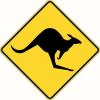During my trials and tribulations on the planemaking front I happened upon a curious situation. I am making a coffin smoother right now and I had my fair share of troubles with a clogging mouth. I used a narrow piece of beech so I could determine easier where the clogging appeared: Shavings were jammed tight in between capiron and the wear of the plane allready on the very first few cm's cutting.
Let me put things in clear order.
I started with a mouth of 0.4 mm. Capiron angle is 45- 50 degrees. Bedding angle is 47.5 degrees, wear angle 75 degrees: Instant clogging.
I turned all my attention towards the capiron. It is now as smooth and polished and gap free as a capiron can be: Still instant clogging.
I cleaned up the wear, opening up the mouth in the mean time. The wear is now highly polished and smooth:
- With the capiron set a little further from the edge: Perfect performance. Thin and thick shavings.
- With the capiron set very close to the edge: Still instant clogging, especially with thin shavings.
I raised the wear angle to 80 degrees: Perfect performance, thin and thick shavings.
So in the end with a 1 mm wide mouth (almost 3/64"), a wear angle of 80 degrees, the capiron angle 45 - 50 degrees and bedding 47.5 degrees, finally a nice working plane.
foto%u00252B%u002525284%u00252529.JPG
I think this is what happens. Shavings love to start with a tight curl. If there is no wear, the shaving keeps on curling and you get a tight roll instead of a long straight shaving. You can see this very well in the Kato video. The wear actually stops the curl from curling any tighter and moves the curl upwards, thus straightening out the shaving.
Curl.jpg
I think there is critical mouth configuration in a wooden plane. Allthough there seems to be plenty of space with a 1mm mouth, you still get a constriction between the bulge of the capiron and the wear which is leaning towards the iron. When there is enough room for the curl to curl, below this constriction, then a clog is almost inevitable. Setting the capiron closer to the edge increases how strongly the shaving is directed towards the wear, thus increasing the problem. And it seems to be worse with lighter shavings, it also seems to be worse when you move the plane slowly over the board.
I couldn't test if a really very tight mouth (0.2 mm?) would prevent this from occuring (preventing the curl from appearing in the first place). But the constriction tightens quite a bit when you make the mouth smaller.
Of course, this was just one example, and I am still very much a beginning plane maker. But I wonder if other people have similar experiences, or maybe had completely different results.




 Reply With Quote
Reply With Quote






